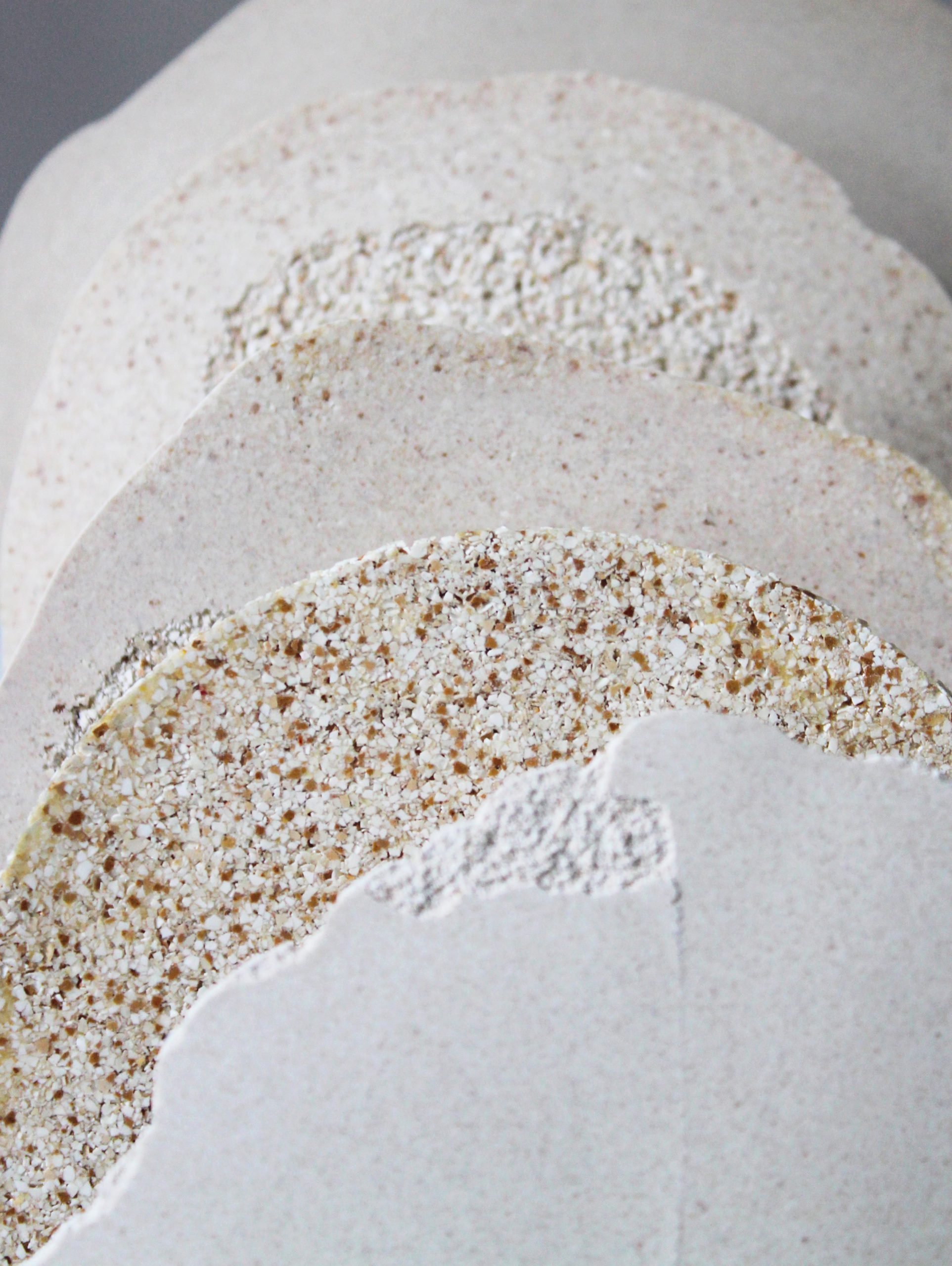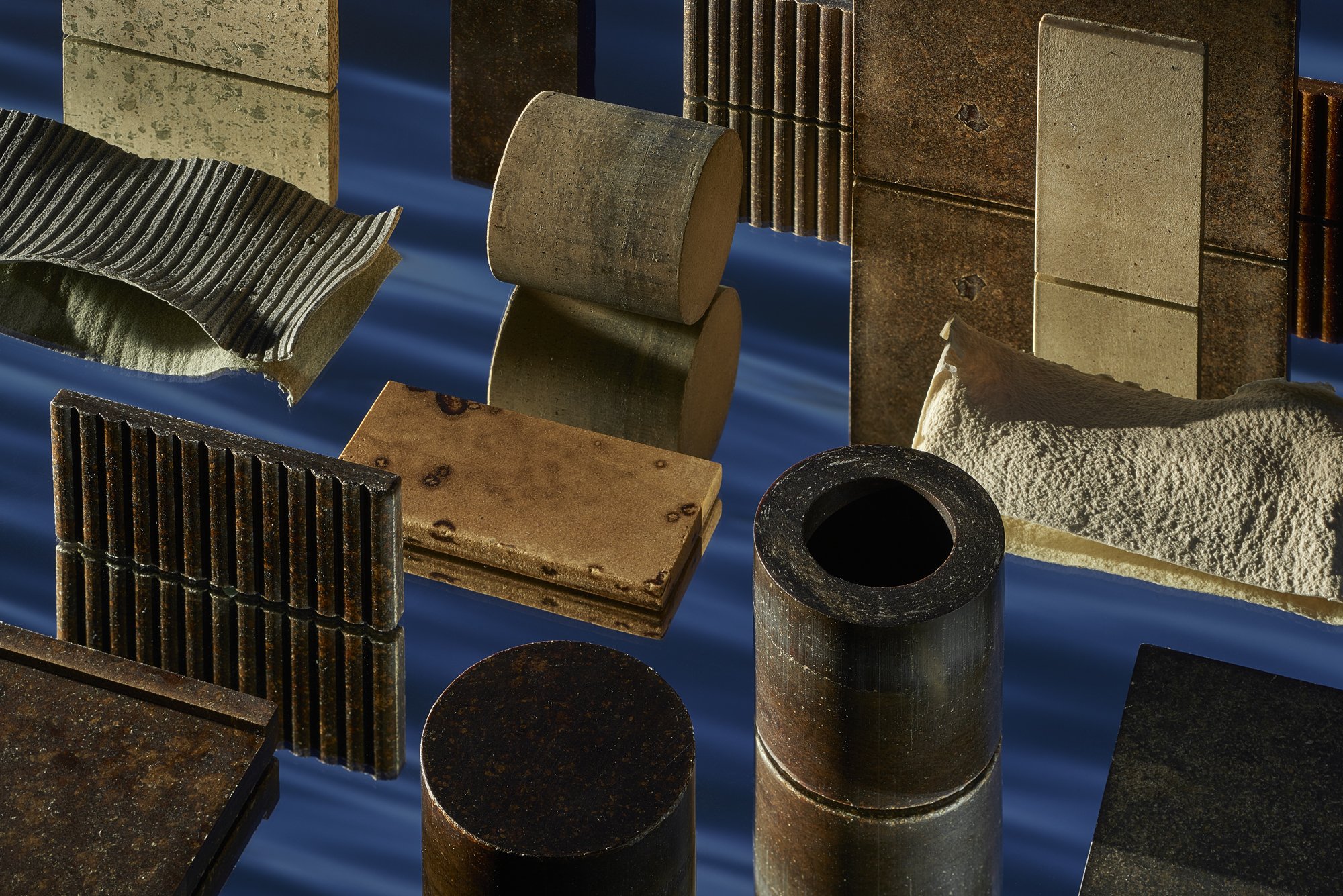Materials & Circularity
A SELECTION OF CIRCULAR PROJECTS AND MATERIALS RESEARCH - MATERIALDISTRICT, UTRECHT, 2022
Eggshell Ceramic by Atelier LVDW, design studio of Laura van de Wijdeven
WORDS Nina Zulian
Environmental challenges are connected with the idea of economic growth. Therefore, it is essential to change our attitude towards excessive consumption and re-examine how we produce and dispose of waste. The Circularity Gap Report 2021 says that of the 59.1 billion tonnes of annual global emissions, 70% is tied to the lifetimes of materials: from extraction, processing and use to disposal.
Consumers play a vital role in the economy, and as consumer spending continues to grow, with middle-class consumers expected to triple by 2030, it's crucial to address wasteful consumerism. The opportunities lie in identifying what consumers can do to adopt a circular lifestyle, enabling them to take responsibility and push for a transition to an inclusive, collaborative, and regenerative world. But to reach the end consumer effectively, corporations need to be more transparent about their extraction of materials, the composition of products, production methods and working conditions.
As circularity gained popularity also has 'circular-washing'. So it's important to clarify that the economic system is beyond recycling and saving energy. Instead, it is about the fundamental shift towards a closed-loop model, where raw materials are kept in use as long as possible, and production processes use raw materials more efficiently so that fewer are needed. Also, it's crucial to innovate through regenerative and renewable materials.
Several sectors are mobilising to achieve circularity, particularly architecture, construction, and design, collaborating with living and biodegradable materials that lessen the negative impact caused by our economic system.
However, as the material innovator Maurizio Montalti explained in an interview for the magazine Frame, the changes needed are not simply about switching from one material to another. Instead, innovative materials and related technologies call for radically changing how we traditionally create and design.
Using that lens, I selected projects and research presented at MaterialDistrict. An event that was held in the city of Utrecht in April 2022 brought together materials manufacturers and specifiers from all spatial design sectors to engage in critical discussion about the path towards a circularly designed and built environment.
*Note: The selected projects are research in progress and aim to rethink and create discussions about circular design to address specific issues.
PineResin by Sarmite Polakova, studio Sarmite
“The recent mass-production era has imprinted in us the need to look for the next superpower material, preferable made of by-products and waste. It is so easy to get obsessed with various solutions – and then slip back in old patterns of focusing only on the price and scale.
However, perhaps the biggest crisis we need to overcome today is the lack of ideas rather than solutions. For example, thinking of alternative production systems, small scale manufacturing and the cycle of materials.
The industry is listening currently very closely and is willing to consider and implement new processes. In order to get there – we, creators, first must visualize these narratives.”
PineResin by Sarmite Polakova, studio Sarmite
Studio Sarmite
The designer Sarmite Polakova researches raw materials and sustainable solutions that could reduce the waste generated by the logging industry. She works with the inner bark of pine trees, a by-product discarded during mass logging, to create a leather-like material named PineSkins.
Through the same research, Sarmite found the potential of another material, the pine resin - an extremely versatile material but sensitive to temperature changes. And rather than fight the resin's characteristics, the designer changed the perspective through the material and incorporated its character into her creations.
As a result, she has developed PineResin, a flexible and multi-purpose material, and with it, she has created a collection of vessels that can be repeatedly re-melted.
"Each vase can be re-melted into the same shape or any new shape. A customer buys the material, not the vase. It is only the function that has broken, not the material. As a producer, I provide this service of collecting the parts back and remaking them into a new product", explains the designer Sarmite Polakova.
Instagram @studio_sarmite
Amber Waste is Bliss by Agne Kucerenkaite
Amber Waste is Bliss by Agne Kucerenkaite
Agne Kucerenkaite
Amber Waste is Bliss is a design and research project by Agne Kucerenkaite. The designer creates leather-like materials and biocomposites with residual flow from jewellery production and small objects made from natural amber.
Amber is a fossilised tree resin that originates from extinct conifer trees. The high-priced material is used to make varnish, incense, decorative objects, jewellery and medicine.
The production of jewellery and carving is usually handmade, with tools such as saws, fine-toothed files, drills, diamond disks, and sandpaper. After crafting amber, a tremendous amount of waste is left, called "amber dust". It can accumulate in tonnes, and just a small amount is commercialised. Mainly because it is contaminated with paper, and thus, the value is lost. Therefore it is disposed of in dumpsters or even sewage.
"A full scope of material research is conducted by softening and melting the amber dust, creating methods, analysing properties, deconstructing it by adding new biomaterials and binders, altering its properties, and changing colours. Amber is transformed into a completely new material to create a range of usable more cost-effective interior products (such as panels, tiles, and furniture parts) and objects," explains Agne Kucerenkaite.
https://www.agne-k.com/projects
Instagram @agne.kucerenkaite
Instagram @makewastematter
Eggshell ceramic by Atelier LVDW
Atelier LVDW
Around 10 billion eggs a year are produced in the Netherlands, making the country the largest egg exporter globally. Eggshell ceramic is a circular material derived from the industry to present new possibilities with this organic waste stream made by Atelier LVDW. The design studio founded by Laura van de Wijdeven developed a biodegradable but strong material from the eggshells, which can be a sustainable replacement for single-use products. The material looks like ceramics but has the weight of cardboard, making it a versatile material. In addition, the material is easily recycled into calcium water, which can be used as a nutrient for lime-loving plants.
https://www.atelierlvdw.nl/eggshellceramic
Instagram @atelierlvdw
Mudernism by Billie van Katwijk
Mudernism - Vase no1 by Billie van Katwijk
Studio Billie van Katwijk
An important residual material of our wastewater purification is sludge, which is incinerated after a composting process. The residue of this combustion is turned into ceramic glazes, which gives the residual material a new aesthetic value.
Billie van Katwijk created Mudernism collection, a ceramic glaze using Kaumera.
The collection celebrates the water cycles with prehistoric design icons glazed with materials recovered from modern wastewater treatment.
https://www.billievankatwijk.com/
Instagram @studiobillievankatwijk
Human Material Loop
Designer Zsófia Kollár founded Human Material Loop, a startup researching human organic waste as a sustainable raw material.
Human Material Loop processes human hair waste and develops high-performance textiles. The project aims at a zero-waste society and is an affordable solution for textile users.
The organic material is spun into yarn and woven or knitted into applicable textile pieces by collecting and processing human hair waste in beauty salons. And by using locally sourced materials, the startup seeks to reduce fossil fuels and associated pollutants, including the greenhouse gas emissions required for transportation. In addition, they aim to fuel the regional economy by supporting local businesses.
https://humanmaterialloop.com/
Instagram @humanmaterialloop
biomaterial by Studio Lionne van Deursen
Studio Lionne van Deursen
The project Unfold by researcher and designer Lionne van Deursen explores the versatility of a material created by living microorganisms. Made from a symbiotic culture of bacteria and yeast and composed of bacterial cellulose, the biofilm becomes a solid material when dry. It is biodegradable and strong, has high flexibility and can be easily moulded and bent into any desired shape.
The project explores the possibilities of creating relief surfaces and three-dimensional objects with sheet material. Using a simple folding technique, complex structures can be created. The folded sheet can expand and contract and transform into more dynamic objects. For example, a folded grid can be bent in different positions to create various shapes.
After the growing process, Lionne van Deursen also experimented with different natural plant dyes and dyes made from fruit waste to see how they affect the material's colour and texture. This study resulted in a collection of fabrics with different colours, transparency levels, and textures.
https://www.lionnevandeursen.com/
Instagram @lionnevandeursen
natural dyes made from fruit waste by Studio Lionne van Deursen
MaterialDistrict
Sources
https://illuminem.com/energyvoices/9cfdf8d5-a635-4a47-be78-ec756c470be6
An interview with MaterialDistrict Utrecht ambassador Leonne Cuppen (Yksi Expo)











